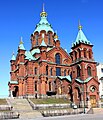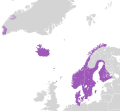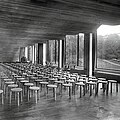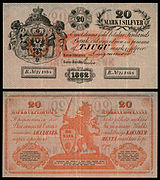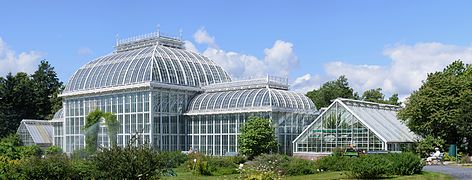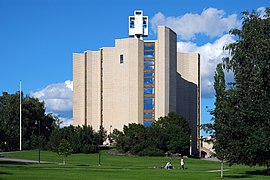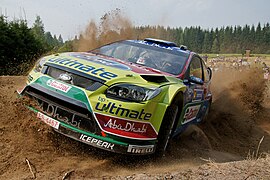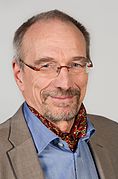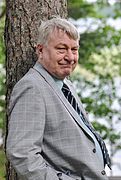The Finland Portal


Finland, officially the Republic of Finland, is a Nordic country in Northern Europe. It borders Sweden to the northwest, Norway to the north, and Russia to the east, with the Gulf of Bothnia to the west and the Gulf of Finland to the south, opposite Estonia. Finland covers an area of 338,145 square kilometres (130,559 sq mi) and has a population of 5.6 million. Helsinki is the capital and largest city. The vast majority of the population are ethnic Finns. The official languages are Finnish and Swedish, of which 84.9 percent of the population speak the first as their mother tongue and 5.1 percent the latter. Finland's climate varies from humid continental in the south to boreal in the north. The land cover is predominantly boreal forest biome, with more than 180,000 recorded lakes.
Finland was first settled around 9000 BC after the last Ice Age. During the Stone Age, various cultures emerged, distinguished by different styles of ceramics. The Bronze Age and Iron Ages were marked by contacts with other cultures in Fennoscandia and the Baltic region. From the late 13th century, Finland became part of the Swedish Empire as a result of the Northern Crusades. In 1809, as a result of the Finnish War, Finland was captured from Sweden and became a Grand Duchy of Finland, an autonomous state ruled by the Russian Empire. During this period, Finnish art flourished and the idea of full independence began to take hold. In 1906, Finland became the first European state to grant universal suffrage, and the first in the world to give all adult citizens the right to run for public office. Following the Russian Revolution of 1917, Finland declared its full independence. In 1918 the young nation was divided by the Finnish Civil War. During World War II, Finland fought against the Soviet Union in the Winter War and the Continuation War, and later against Nazi Germany in the Lapland War. As a result, it lost parts of its territory but retained its independence. (Full article...)
Selected article -
Selected image -
Did you know (auto-generated)

- ... that the 1972 Finnish film The Sheep Eaters gathered more than a million viewers opposite the 1975 Ice Hockey World Championships match between Finland and the Soviet Union?
- ... that Theodolinda Hahnsson is the first known Finnish-language female author?
- ... that Sodankylä Old Church is one of the oldest preserved wooden churches in Finland?
- ... that the Finnish 7th Division was formed in 1940 by renumbering another unit to make it appear to the Soviets that it had been replaced with fresh troops?
- ... that records of transgender people in Finland stretch back to the 19th century?
- ... that Kimmo Leinonen helped establish both the Finnish Hockey Hall of Fame and the IIHF Hall of Fame?
WikiProjects

You are invited to participate in Finland WikiProject, a WikiProject dedicated to developing and improving articles about Finland.
More did you know -
- ...that the prototypes for the WW II German U-boat fleet (Type II pictured) were designed by a Dutch company and built in Finland at the Crichton-Vulcan shipyard?
- ...that while repelling Soviet advances across the frozen Lake Suvanto, Finland managed to capture 12 anti-tank guns, 140 machine guns, 200 light machine guns and 1500 rifles in the Battle of Kelja in 1939?
- ...that Major Carl Mothander, the leader of Swedish volunteers in the Estonian War of Independence, later wrote books on Estonian politics that were banned in Finland?
- ...that the Korpela movement was a short-lived cult during the 1930s in Northern Sweden and Finland whose controversial sexual rituals eventually led to the arrest of 60 followers?
- ...that in 1745, Daniel Juslenius, a Finnish Fennoman, finished the first formal Finnish dictionary?
Sami Sakari Salo (born 2 September 1974) is a Finnish former professional ice hockey defenceman of the National Hockey League (NHL). He began his professional career with TPS of the SM-liiga before being selected by the Ottawa Senators with their last pick in the 1996 NHL Entry Draft.
He joined the Senators in 1998–99 and was selected to the NHL All-Rookie Team. In the 2002 off-season, he was traded to the Vancouver Canucks with whom he recorded three 30-point campaigns. Prior to the 2012–13 NHL season he signed with the Lightning as a free agent. Due to the 2004–05 NHL lockout, Salo played overseas with Frölunda HC of the Swedish Elite League and helped the club capture the Le Mat Trophy as league champions. Internationally, Salo has competed for Finland, appearing in two World Championships, three Winter Olympics and one World Cup. He won silver medals at the 2001 World Championships and the 2006 Winter Olympics, as well as a bronze medal at the 2010 Winter Olympics. (Full article...)General images
In the news
- 22 May 2024 – Russia–NATO relations
- The Russian Ministry of Defence proposes to unilaterally adjust Russia's maritime border in the Baltic Sea, prompting comments of concern made by Baltic members of NATO, including Finland and Lithuania. The Ministry of Defense later retracts the proposal. (Reuters) (BBC News)
- 2 April 2024 – Viertola school shooting
- A student is killed and two others are injured in a shooting at a school in Vantaa, Uusimaa, Finland. A 12-year-old student is detained. (AP) (Yle)
- 1 March 2024 – 2024 Finnish presidential election
- Alexander Stubb is sworn in as the 13th President of Finland. (Reuters)
- 11 February 2024 – 2024 Finnish presidential election
- Alexander Stubb is elected President of Finland with 51.6% of the vote.(Yle)
- 27 January 2024 – Israel–Hamas war
- The United Kingdom, United States, Australia, Italy, Canada, Finland, the Netherlands, Switzerland, and Germany suspend humanitarian aid to UNRWA over allegations that some UNRWA staff members were involved in the Hamas-led attack on Israel. (BBC News) (CBS News)
- 14 December 2023 – Finland–United States relations
- Finland announces the creation of a defense cooperation agreement with the United States. The agreement will grant Finland access to American military resources for use in defensive operations, while the US will gain military access to Finland in the event of conflict. (Reuters)
Related portals
Northern Europe
Other countries
Selected panorama -
Topics
Categories
Recognized content
Things you can do
- Add the ((Portal|Finland)) template to existing See also sections of Finland-related articles.
- Tag the talk pages of Finland-related articles with the ((WikiProject Finland)) template. (Tip: Use PetScan to find articles not tagged yet by replacing the category "Finnish films" with another category and adjust "Depth" if needed. This tool is helpful for tagging. See also the list of pages not tagged yet.)
- Rate unassessed and unknown-importance articles according to the guidelines. (This tool is helpful for doing these.)
- Translate a Finnish-language article into English.
- Expand a stub into a full article.
- Help with the articles needing attention (watch) and cleanup.
- Create a requested article (watch).
- Support fresh articles (watch).
- Patrol the recent changes.
- Add the following pages to your watchlist:
Associated Wikimedia
The following Wikimedia Foundation sister projects provide more on this subject:
-
Commons
Free media repository -
Wikibooks
Free textbooks and manuals -
Wikidata
Free knowledge base -
Wikinews
Free-content news -
Wikiquote
Collection of quotations -
Wikisource
Free-content library -
Wikiversity
Free learning tools -
Wikivoyage
Free travel guide -
Wiktionary
Dictionary and thesaurus





